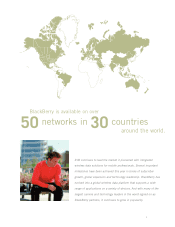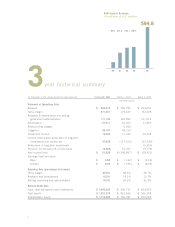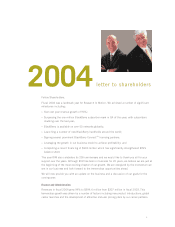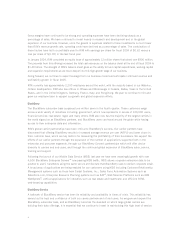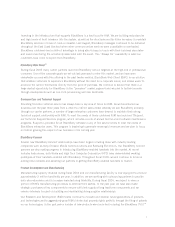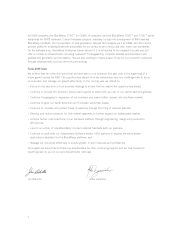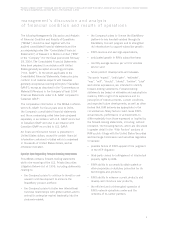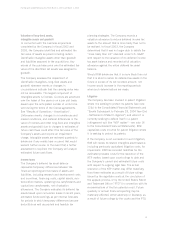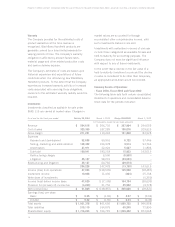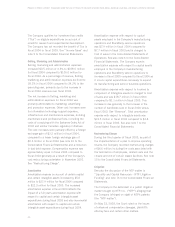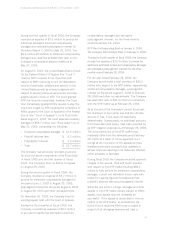Blackberry 2004 Annual Report Download - page 15
Download and view the complete annual report
Please find page 15 of the 2004 Blackberry annual report below. You can navigate through the pages in the report by either clicking on the pages listed below, or by using the keyword search tool below to find specific information within the annual report.
13
For the years ended February 28, 2004, March 1, 2003 and March 2, 2002
Valuation of long-lived assets,
intangible assets and goodwill
In connection with the business acquisitions
completed by the Company in fiscal 2002 and
2003, the Company identified and estimated the
fair value of assets acquired including certain
identifiable intangible assets other than goodwill
and liabilities assumed in the acquisitions. Any
excess of the purchase price over the estimated fair
value of the identified net assets was assigned to
goodwill.
The Company assesses the impairment of
identifiable intangibles, long-lived assets and
goodwill whenever events or changes in
circumstances indicate that the carrying value may
not be recoverable. The largest component of
Intangible assets is licenses. Licenses are amortized
over the lesser of five years or on a per unit basis
based upon the anticipated number of units to be
sold during the terms of the license agreements.
See “Results of Operations – Amortization”.
Unforeseen events, changes in circumstances and
market conditions, and material differences in the
value of licenses and other long-lived and intangible
assets and goodwill due to changes in estimates of
future cash flows could affect the fair value of the
Company’s assets and require an impairment
charge. Intangible assets are reviewed quarterly to
determine if any events have occurred that would
warrant further review. In the event that a further
assessment is required, the Company will analyze
estimated future cash flows.
Income taxes
The Company’s deferred tax asset balance
represents temporary differences between the
financial reporting and tax bases of assets and
liabilities, including research and development costs
and incentives, financing costs, capital assets, non-
deductible reserves, operating loss carryforwards and
capital loss carryforwards, net of valuation
allowances. The Company evaluates its deferred tax
assets based upon cumulative losses in recent years,
estimated future earnings as per internal forecasts
for periods in which temporary differences become
deductible as well as prudent and feasible tax
planning strategies. The Company records a
valuation allowance to reduce deferred income tax
assets to the amount that is more likely than not to
be realized. In fiscal 2003, the Company
determined that it was no longer able to satisfy the
“more likely than not” standard under U.S. GAAP
with respect to the valuation of its deferred income
tax asset balance and recorded a full valuation
allowance against the entire deferred tax asset
balance.
Should RIM determine that it is more likely than not
that it is able to realize its deferred tax assets in the
future in excess of its net recorded amount, net
income would increase in the reporting periods
when such determinations are made.
Litigation
The Company has been involved in patent litigation
where it is seeking to protect its patents (see note
12(b) to the Consolidated Financial Statements and
“Events Subsequent to February 28, 2004 Year End
- Settlement of Patent Litigation”) and where it is
currently seeking to defend itself in a patent
infringement suit (the “NTP matter” - see note 16
to the Consolidated Financial Statements). RIM
capitalizes costs incurred for patent litigation where
it is seeking to protect its patents.
If the Company is not successful in such litigation,
RIM will review its related intangible asset balance,
including previously capitalized litigation costs, for
impairment. RIM has recorded liabilities for the
estimated probable costs for the resolution of the
NTP matter, based upon court rulings to date and
the Company’s current and estimated future costs
with respect to ongoing legal fees. The actual
resolution of the NTP matter may differ materially
from these estimates as a result of future rulings
issued by the appellate courts at the conclusion of
the appeals process, or by the United States Patent
and Trademark Office (“PTO”) in connection with its
re-examinations of the five patents-in-suit. Future
quarterly or annual financial reporting may be
materially affected, either adversely or favorably, as
a result of future rulings by the courts and the PTO.


